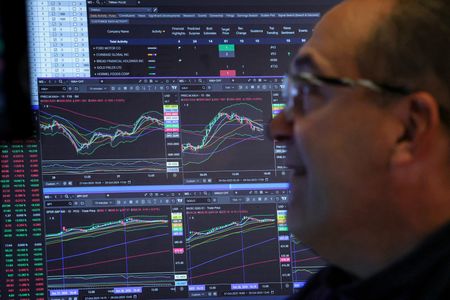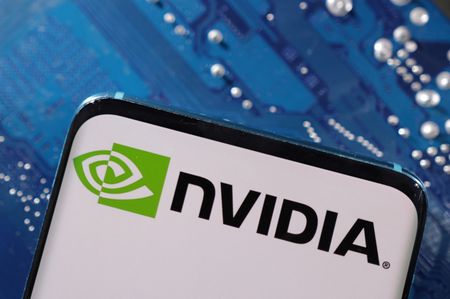By Sinéad Carew and Pranav Kashyap
(Reuters) -Wall Street’s three major indexes lost ground on Thursday with the Nasdaq Composite and the S&P 500 leading losses as Meta and Microsoft shares tumbled on worries over surging AI spending, while investors also digested a more hawkish tone from the U.S. Federal Reserve.
Meta shares sank 11.3% for their biggest one-day drop in three years after the social media company forecast “notably larger” capital expenses next year, thanks to investments in artificial intelligence.
Microsoft shares ended down 2.9% after the software company reported a record capital expenditure of nearly $35 billion for its fiscal first quarter and warned that spending would rise this year.
In contrast, however, Google-parent Alphabet finished up 2.5% as steady growth in advertising and cloud computing powered better-than-expected results.
The results followed the Federal Reserve’s delivery on Wednesday of a widely expected quarter-point rate cut but it raised doubts about future policy moves when Chair Jerome Powell said that another cut in December was not a “foregone conclusion.” This had led traders to pare back the odds of another cut in December to about 70%, down from more than 90% earlier in the week.
“Investors are in a risk-off mood after the market’s been on a run. The S&P 500’s near a record high but these technology earnings didn’t meet the elevated expectations,” said Lindsey Bell, chief strategist at 248 Ventures in Charlotte, North Carolina, also pointing to investor worries about the economic data vacuum due to the government shutdown and a more hawkish Fed.
Bell noted that neither Microsoft, Meta nor Alphabet “was able to significantly clarify when we’re going to get a return on the AI investments.” She didn’t expect any better clarity from closely watched Apple and Amazon results, which came out late on Thursday.
However, after closing the regular session down 3%, Amazon shares were up 9% in late trading as strong demand for its cloud computing services countered weaker growth in its e-commerce business. Apple shares rose in choppy after-the-bell trading following its report, which showed strong iPhone sales with some supply constraints.
Of the 222 S&P 500 companies that have reported so far, 84.2% have beaten earnings estimates as of Wednesday, according to LSEG data. That’s above the 77% average over the past four quarters.
The Dow Jones Industrial Average fell 109.88 points, or 0.23%, to 47,522.12, the S&P 500 lost 68.25 points, or 0.99%, to 6,822.34 and the Nasdaq Composite lost 377.33 points, or 1.57%, to 23,581.14.
Among the S&P 500’s 11 major industry sectors, seven declined with consumer discretionary leading losses with a 2.6% drop. Real estate was the biggest gainer, adding 0.7%.
Thursday’s pullback followed record highs in the three major indexes during the past four sessions, lifted by optimism around quarterly earnings and expectations for a more accommodative monetary policy stance.
Also, optimism around AI has been a key driver of the bull run in U.S. stocks this year, with the top tech companies collectively accounting for 35% of the weight of the S&P 500.
AI chip leader Nvidia fell 2% on Thursday after it had given the market an extra boost the day before, when it became the first publicly listed company to surpass $5 trillion in market capitalization.
Meanwhile, a widely anticipated trade agreement between U.S. President Donald Trump and Chinese President Xi Jinping appeared to do little to boost stocks on the day.
Trump agreed to roll back some tariffs on Chinese imports in exchange for Beijing resuming soybean purchases, keeping rare earth exports flowing, and cracking down on fentanyl trafficking.
“When you get good news and markets don’t react to it that tells you it’s probably already discounted,” said Jack McIntyre, portfolio manager at Brandywine Global.
In other stocks, drug distributor Cardinal Health rallied 15.4% after raising its annual adjusted profit forecast.
Chipotle Mexican Grill shares tumbled 18.2% after the burrito chain axed its annual sales forecast, with tariffs and inflation squeezing margins.
Declining issues outnumbered advancers by a 2.1-to-1 ratio on the NYSE where there were 177 new highs and 172 new lows on the NYSE.
On the Nasdaq, 1,565 stocks rose and 3,095 fell as declining issues outnumbered advancers by a 1.98-to-1 ratio. The S&P 500 posted 34 new 52-week highs and 37 new lows while the Nasdaq Composite recorded 88 new highs and 187 new lows.
On U.S. exchanges 20.32 billion shares changed hands compared with the 21.08 billion average for the last 20 sessions.
(Reporting by Sinéad Carew in New York, Pranav Kashyap and Nikhil Sharma in Bengaluru; Editing by Krishna Chandra Eluri, Shinjini Ganguli and Aurora Ellis)










